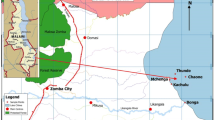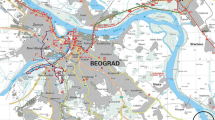Abstract
The concentrations of metals (Ca, Cd, Fe, Mn, Pb and Zn) were determined by flame atomic absorption spectrophotometry in water, sediments and fish samples in the Ogun river catchments, Ketu, Lagos, which is an important bird nesting, fishing and drinking water source. The results show that the southern tip bothering the Lagos lagoon is where the highest metal concentrations are found in the fish species (Tilapia sp. and Chrysichthys sp.), whereas the Agboyi creek segment near the lagoon with higher surrounding human population density recorded higher levels of metals in sediments and water samples. The two fish species accumulated different amounts of metals. However, the differences were not statistically different at p<0.05. There is a significant correlation (p<0.05) for Cd concentration in water. The concentrations of Pb in sampling points 3 and 4 as well as Cd, Mn and Fe in all six sampling points exceeds the World Health Organization (WHO) limits for drinking water. Levels of metals obtained for sediments are within the range reported for Nigeria’s river sediments. Based on this study, the human risks for heavy metals in the harvested fish species from the Ogun river catchments, Ketu, are low for now as the concentrations were below the recommended Food and Agriculture Organization (FAO) maximum limits for Pb (0.5 mg/Kg), Cd (0.5 mg/Kg), and Zn (30 mg/Kg) in fish.
Similar content being viewed by others
References
Adeniyi, A. A., & Oyedeji, O. O. (2001). Determination of total petroleum hydrocarbons (TPH), organic carbon and heavy metals in soils adjoining the National Arts Theatre water front and Abegede Creek, Ijora, Lagos. Fresenius Environmental Bulletin, 10, 873–876.
Adeniyi, A. A., & Okedeyi, O. O. (2004). Assessing the speciation pattern of lead and zinc in surface water collected from Abegede creek, Ijora, Lagos. Pakistan Journal of Scientific and Industrial Research, 47, 430–434.
Almeida, J. A., Novelli, E. L. B., DalPai Silva, M., & Alves, R., Jr. (2001). Environmental cadmium and metabolic responses of Nile tilapia. Environmental Pollution, 114, 169–175.
Altindag, A., & Yigit, S. (2005). Assessment of heavy metal concentrations in the food web of lake Beysehir, Turkey. Chemosphere, 60, 552–556.
America Public Health Association (1998). Standard methods for the examination of water and wastewater, APHA, AWWA, and WPCE (20th ed.). America Public Health Association. Springfield, New York: Byrd Progress.
Arienzo, M., Adamo, P., Bianco, M. R., & Violante, P. (2001). Impact of land use and urban run-off on the contamination of the Samo river basin in southwestern Italy. Water, Air, and Soil Pollution, 131, 349–366.
Awofolu, O. R., Mbolekwa, Z., Mtshemla, V., & Fatoki, O. S. (2005). Levels of trace metals in water and sediment from Tyume river and its effects on an irrigated farmland. Water South Africa, 31, 87–94.
Berkun, M. (2005). Effects of Ni, Cr, Hg, Cu, Zn, Al, on the dissolved oxygen balance of streams. Chemosphere, 59, 207–215.
Biney, C., Amuzu, A. T., Calamari, D., Kaba, N., Mbone, I. L., Naeve, H., et al. (1994). Review of heavy metals in the African aquatic environment. Ecotoxicology and Environmental Safety, 28, 134–159.
Canli, M., & Furness, R. W. (1993). Toxicity of heavy metals dissolved in seawater and influences of sex and size on metal accumulation and tissue distribution in the Norway lobster Nephrops norvegicus. Marine Environment Research, 36, 217–236.
Castro, H., Aguilera, P. A., Martinez, J. L., & Carrique, E. L. (1999). Differentiation of clams from fishing areas an approximation of coastal quality assessment. Environmental Monitoring and Assessment, 54, 229–237.
Chan, H. M., Trifonopoulos, M., Ing, A., Receveur, O., & Johnson, E. (1999). Consumption of freshwater fish in Kahnawake: Risks and benefits. Environmental Research, 80, 213–222.
Chari, K. B., & Abbasi, S. A. (2005). A study on the fish fauna of Oussudu — A rare freshwater lake of south India. International Journal of Environmental Studies, 62, 137–145.
Chen, C. Y., Stemberger, R. S., Klaue, B., Blum, J. D., Pickhardt, C., & Folt, C. L. (2000). Accumulation of heavy metals in food web components across a gradient of lakes. Limnology Oceanography, 45, 1525–1536.
Davis, A. P., Shokouhran, M., & Ni, S. (2001). Loading estimates of lead, copper, cadmium and zinc in urban run-off from specific sources. Chemosphere, 44, 997–1009.
Department of Water Affairs and Forestry (DWAF) (1992). Analytical methods manual TR151. Hydrological research institute, DWAF, Pretoria.
Edwards, J. W., Edyvane, K. S., Boxall, V. A., Hamann, M., & Sole, K. L. (2001). Metal levels in Sexton and marine fish flesh near industrial and metropolitan Centers in south Australia. Marine Pollution Bulletin, 42, 389–396.
Everall, N. C., Macfarlane, N. A. N., & Sedgawick, R. W. (1989). The interactions of water hardness and pH with other acute toxicity of Zn to the brown trout Salmo trutta L. Journal Fisheries Biology, 35, 27–30.
Food and Agriculture Organization (FAO) (1983). Compilation of legal limits for hazardous substances in fish and fishery products. FAO Fishery Circular No. 464.
Ikem, A., Egiebor, N. O., & Nyavor, K. (2003). Trace elements in water, fish and sediment from Tuskegee lake, southeastern U.S.A. Water, Air and Soil Pollution, 149, 51–75.
James, M. O., & Okolo, P. O. (2003). Variation of heavy metal concentrations in water and freshwater fish in Niger Delta waters. Pakistan Journal of Scientific and Industrial Research, 46, 439–442.
Jenkins, P., Southern, T., Truesdale, V., & Jeary, A. (1996). Waters. In S. Watts & L. Halliwell (Eds.), Essential environmental science. Methods and techniques (pp. 336–350). London: Routledge.
John, C. (2001). Spatial distribution of total cadmium, copper, and zinc in the Zebra mussel Dreissena polymorpha along the upper St. Lawrence river. Journal Great Lakes Research, 27, 354–366.
Johnson, R. K., Wiederholm, T., & Rosenberg, D. M. (1993). Freshwater biomonitoring using individual organisms, populations and species assemblages of benthic macroinvertebrates. In D. M. Rosenberg & V. H. Resh (Eds.), Freshwater biomonitoring and benthic macroinvertebrates (pp. 287–305). New York: Chapman & Hall.
Lewis, J. A., & Cohen, S. M. (2004). Addressing lead toxicity: Complexation of lead II with thiopyrone and hydroxypridine O, S mixed chelators. Inorganic Chemistry, 43, 6534–6536.
Licata, P., Bella, G. D., Dugo, G., & Naccari, F. (2003). Organochlorine pesticides, PCBs. and heavy metals in tissues of the Mullet Liza aurata in Lake Ganzirri and straits in Messina (Sicily, Italy). Chemosphere, 52, 231–238.
Monteiro, P. M. S., & Roychoudhury, A. N. (2005). Spatial characteristics of sediment trace metals in an eastern boundary upwelling retention area (St. Helena Bay, South Africa). A hydrodynamic-biological pump hypothesis. Estuarine Coastal and Shelf Science, 65, 123–134.
Naqvi, S. M., & Howell, R. D. (1993). Cadmium and lead uptake by red swap crayfish Procambrus Clarkii of Lousiana. Bulletin Environmental Contamination Toxicolology, 51, 296–302.
Patnaik, P. (1997). Handbook of environmental analysis. Chemical pollutants in air, water, soil and solid wastes. New York: Lewis.
Pempkowiase, J., Sikora, A., & Biernacka, E. (1999). Speciation of heavy metals in marine sediments and their bioaccumulation by mussels. Chemosphere, 39, 313–321.
Pentecost, A. (1999). Analyzing environmental data. London: Longman.
Radwan, S., Kowalik, W., & Kornijow, R. (1990). Accumulation of heavy metals in a lake ecosystem. The Science of the Total Environment, 96, 121–129.
Reice, S. R., & Wohlenberg, M. (1993). Monitoring freshwater benthic macroinvertebrates and benthic processes: Measures for assessment of ecosystem health. In D. M. Rosenberg & V. H. Resh (Eds.), Freshwater biomonitoring and benthic macroinvertebrates (pp. 287–305). New York: Chapman and Hall.
Sanders, M. J., DuPreez, H. H., & VanVuren, J. H. J. (1999). Monitoring cadmium and zinc contamination in freshwater systems with the use of the freshwater river crab, Potamonautes warreni. Water South Africa, 25, 91–98.
Sekhar, K. C., Chary, N. S., Kamala, C. T., Raj, D. S. S., & Rao, A. S. (2003). Fractionation studies and bioaccumulation of sediment-bound Heavy Metals in Kolleru lake by edible fish. Environment International, 29, 1001–1008.
Soltan, M. E., & Rashed, M. N. (2000). Impact of the waste dump ecosystem (phosphate ore dressing manufacture, Aswan, Egypt), on the surrounding environment. International Journal of Environmental Studies, 57, 265–282.
Szefer, P, Ali, A. A., Ba-Haroon, A. A., Rajeh, A. A., Geldon, J., & Nabrzyski, M. (1999). Distribution and relationships of selected trace metals in molluscs and associated sediments from the Gulf of Aden, Yemen. Environmental Pollution, 106, 299–314.
Techernitchin, N. N., Villagra, A., & Techernitchin, A. N. (1998). Antiestrogenic activity of lead. Environmental Toxicology and Water Quality, 13, 43–53.
United Nations Environment Program (UNEP) (1986). Environmental capacity: An approach to marine pollution prevention, UNEP Regional Seas Reports and Studies No. 80, UNEP.
United States Environmental Protection Agency (USEPA) (1986). Quality criteria for water. United States Environmental Protection Agency Office of Water Regulations and Standards, Washington DC, 20460.
Usero, J., Gonzalez-Regalado, E., & Graccia, I. (1997). Trace metals in the bivalve molluscs Ruditapes decussatus and Ruditapes philippinarum from the Atlantic coast of southern Spain. Environment International, 23, 291–298.
Usero, J., Morillo, J. & Graccia, I. (2005). Heavy metal concentrations in molluscs from the Atlantic coast of southern Spain. Chemosphere, 59, 1175–1181.
van Aardt, W. J., & Booysen, J. (2004). Water hardness and the effects of Cd on oxygen consumption, plasma chlorides and bioaccumulation in Tilapia sparrmanii. Water South Africa, 30, 57–64.
Wang, X., & Zhuo, Q. (2005). Ecotoxicological effects of cadmium on three ornamental plants. Chemosphere, 60, 16–21.
World Health Organization (WHO) (1996). Guidelines for drinking water quality, vol. 2 (2nd ed.). Geneva: World Health Organization.
Yilmaz, A. B. (2003). Levels of heavy metals (Fe, Cu, Ni, Cr, Pb and Zn) in tissue of Mugil cephalus and Trachurus mediteraneus from Iskenderun Bay, Turkey. Environmental Research, 92, 277–281.
Yusuf, K. A., & Osibanjo, O. (2006). Trace metals in water and sediments from Ologe lagoon, southwestern Nigeria. Pakistan Journal of Scientific and Industrial Research, 49, 88–89.
Author information
Authors and Affiliations
Corresponding author
Rights and permissions
About this article
Cite this article
Adeniyi, A.A., Yusuf, K.A. & Okedeyi, O.O. Assessment of the exposure of two fish species to metals pollution in the Ogun river catchments, Ketu, Lagos, Nigeria. Environ Monit Assess 137, 451–458 (2008). https://doi.org/10.1007/s10661-007-9780-5
Received:
Accepted:
Published:
Issue Date:
DOI: https://doi.org/10.1007/s10661-007-9780-5




